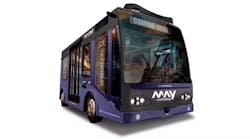More Bus Service will Connect Seattle Riders with Light Rail in 2016
Tens of thousands of riders will have access to better, more frequent bus and light-rail service between Seattle neighborhoods and the region under plans approved today by the King County Council. Changes are slated for 2016 when swift, reliable light-rail service is extended from downtown Seattle to Capitol Hill and the University of Washington.
"We're connecting riders to light-rail service that will get them from downtown Seattle to UW in eight minutes and to Capitol Hill in four minutes, every time – regardless of traffic or weather," said King County Executive Dow Constantine, who is also chair of the Sound Transit Board of Directors. "By creating a more seamless, integrated transit system, we're providing riders with more options to get where they want to be."
King County Council Chair Larry Phillips sponsored changes to three dozen Metro bus routes recommended by County Executive Constantine. The changes were designed over the course of a year with the help and input from thousands of bus riders and an advisory board seeking to make Metro bus connections more frequent and reliable in North Seattle, Capitol Hill and the Central Area.
"Restructuring our transit network helps leverage the investment taxpayers have made in light rail ensuring that bus riders get to the light rail stations with frequent and reliable service," said Council Chair Larry Phillips, prime sponsor of the ordinance. "These new travel opportunities will expand, integrate and improve our transit systems, and better serve our transit riders."
Fully integrating Metro and Sound Transit services
The improved transit network fulfills the Executive's direction to more fully integrate Metro and Sound Transit to create greater operating efficiencies and expand service. King County also worked closely with the City of Seattle on restructuring bus service. In a separate vote today, the County Council also approved the separation and extensions of RapidRide C and D lines, under contract with the City of Seattle using Prop 1 funds. RapidRide C will extend to South Lake Union; RapidRide D will extend to Pioneer Square.
"Thanks to Seattle voters, we expanded RapidRide service this year for Ballard and West Seattle riders," said Seattle Mayor Ed Murray. "Now we are taking that service to the next level, by extending RapidRide to major employment centers in South Lake Union and Pioneer Square. We are making the C and D lines a faster, more direct commute to work."
Changes are in the works for 36 existing Metro routes that primarily serve North and Central Seattle, including investments funded last year by voters in Seattle. Five new routes also would be added. Drawing on public feedback, further refinements also were adopted by the council to meet concerns of riders, including retaining some service on route 43 and a segment of route 71, both previously slated for deletion. Overall, an estimated 80,000 daily bus riders will see more buses per hour on designated corridors in Northeast Seattle and Capitol Hill, with better local service connecting neighborhoods with the new light rail stations.
Changes as originally recommended are posted online. Updated information and maps will be added to the Metro website in coming weeks to reflect the final restructure as approved by the council.
"While today's proposal is not perfect, I believe that on the whole it improves service and access to transit for more riders," said King County Councilmember Rod Dembowski, chair of the Transportation, Economy, and Environment (TrEE) Committee. "I am glad that we were able to retain commuter service in northeast Seattle including peak service on the route 43, a revised route 71 to the University District, and added peak service to several routes, including a significant expansion of routes 76 and 316."
"The opening of three light rail stations in our county next year will change many people's commute," said King County Councilmember Joe McDermott. "It is imperative that we have a system that works together to integrate these new stations and that bus routes serve the stations. The collaboration accomplished with these agreements today represent a new era in transportation planning and integration."
More improvements to come
In coming months, Metro and Sound Transit plan extensive community outreach efforts to help riders prepare for the revised transit network. King County Metro, Sound Transit, the City of Seattle, and the University of Washington are working together to make it as easy and convenient for riders to use the proposed improved and more frequent grid network of bus service. Riders will experience transfers that are as convenient as possible between frequent buses and light rail trains. Also, stops will be relocated at key transfer points, and transit agencies and the city are coordinating better wayfinding, signage, and passenger information, and shelters and lighting at stops.
Other changes approved by the County Council:
Route 200 will be modified to respond to community feedback and better serve Issaquah riders by connecting to Swedish Medical Center Issaquah and deleting a low-ridership loop near Issaquah High School.
Implementation of the first phase of the Southeast King County Alternative Services project, including frequency improvements for DART Route 915.
More peak service on Interstate 5 in the south corridor, implementing a Washington State Department of Transportation Regional Mobility Grant on routes 179 and 190. Adding two morning and two afternoon peak trips to both routes 179 and 190 will allow Metro to serve more riders, relieve crowding on existing service and reduce single-occupancy vehicle traffic.


